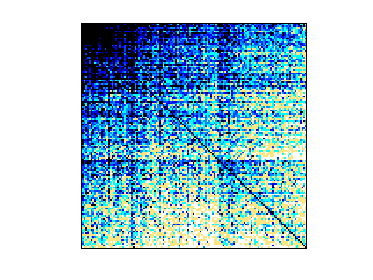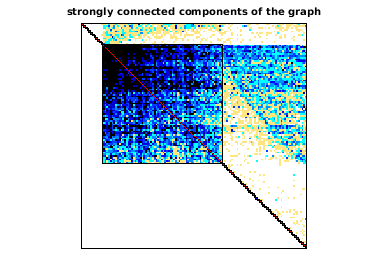SNAP/sx-mathoverflow
SNAP network: Math Overflow temporal network
| Name |
sx-mathoverflow |
| Group |
SNAP |
| Matrix ID |
2793 |
|
Num Rows
|
24,818 |
|
Num Cols
|
24,818 |
|
Nonzeros
|
239,978 |
|
Pattern Entries
|
239,978 |
|
Kind
|
Directed Temporal Multigraph |
|
Symmetric
|
No |
|
Date
|
2017 |
|
Author
|
A. Paranjape, A. R. Benson, and J. Leskovec |
|
Editor
|
J. Leskovec |
| Structural Rank |
|
| Structural Rank Full |
|
|
Num Dmperm Blocks
|
|
|
Strongly Connect Components
|
11,626 |
|
Num Explicit Zeros
|
0 |
|
Pattern Symmetry
|
35.1% |
|
Numeric Symmetry
|
16.1% |
|
Cholesky Candidate
|
no |
|
Positive Definite
|
no |
|
Type
|
integer |
| Download |
MATLAB
Rutherford Boeing
Matrix Market
|
| Notes |
SNAP (Stanford Network Analysis Platform) Large Network Dataset Collection,
Jure Leskovec and Anrej Krevl, http://snap.stanford.edu/data, June 2014.
email: jure at cs.stanford.edu
Math Overflow temporal network
https://snap.stanford.edu/data/sx-mathoverflow.html
Dataset information
This is a temporal network of interactions on the stack exchange web site
Math Overflow (http://mathoverflow.net/). There are three different types
of interactions represented by a directed edge (u, v, t):
user u answered user v's question at time t (in the graph
sx-mathoverflow-a2q) user u commented on user v's question at time t (in
the graph sx-mathoverflow-c2q) user u commented on user v's answer at time
t (in the graph sx-mathoverflow-c2a)
The graph sx-mathoverflow contains the union of these graphs. These graphs
were constructed from the Stack Exchange Data Dump. Node ID numbers
correspond to the 'OwnerUserId' tag in that data dump.
Dataset statistics (sx-mathoverflow)
Nodes 24,818
Temporal Edges 506,550
Edges in static graph 239,978
Time span 2350 days
Dataset statistics (sx-mathoverflow-a2q)
Nodes 21,688
Temporal Edges 107,581
Edges in static graph 90,489
Time span 2350 days
Dataset statistics (sx-mathoverflow-c2q)
Nodes 16,836
Temporal Edges 203,639
Edges in static graph 101,329
Time span 2349 days
Dataset statistics (sx-mathoverflow-c2a)
Nodes 13,840
Temporal Edges 195,330
Edges in static graph 81,121
Time span 2350 days
Source (citation)
Ashwin Paranjape, Austin R. Benson, and Jure Leskovec. "Motifs in Temporal
Networks." In Proceedings of the Tenth ACM International Conference on Web
Search and Data Mining, 2017.
Files
File Description
sx-mathoverflow.txt.gz All interactions
sx-mathoverflow-a2q.txt.gz Answers to questions
sx-mathoverflow-c2q.txt.gz Comments to questions
sx-mathoverflow-c2a.txt.gz Comments to answers
Data format
SRC DST UNIXTS
where edges are separated by a new line and
SRC: id of the source node (a user)
TGT: id of the target node (a user)
UNIXTS: Unix timestamp (seconds since the epoch)
---------------------------------------------------------------------------
Notes on inclusion into the SuiteSparse Matrix Collection, July 2018:
---------------------------------------------------------------------------
The SNAP graph is 1-based, with nodes in all graphs numbered 1 to
n=88,580.
In the SuiteSparse Matrix Collection, the primary matrix, Problem.A, is
the overall static graph, with 239,978 edges, of size n-by-n with
n=24,818. These edges represent the 506,550 temporal edges. A(i,j) is
the number of times person u=nodeid(i) interacted with person v=nodeid(j),
with a temporal edge (u,v,t), with any kind of interaction.
Problem.aux.nodeid is a list of the node id's that appear in the SNAP data
set.
A2Q = Problem.aux.Q2A is the static sx-mathoverflow-a2q graph.
C2Q = Problem.aux.C2Q is the static sx-mathoverflow-c2q graph.
C2A = Problem.aux.C2A is the static sx-mathoverflow-c2a graph.
These sum together to give the the overall graph. That is,
A = A2Q + C2Q + C2A.
A2Q(u,v) is the number of times person u answered v's questions.
C2Q(u,v) is the number of times person u commented on v's question.
C2A(u,v) is the number of times person u commented on v's answer.
The temporal edges are held in:
Problem.aux.temporal_edges: [506550x3]
Problem.aux.temporal_edges_a2q: [107581x3]
Problem.aux.temporal_edges_c2q: [203639x3]
Problem.aux.temporal_edges_c2a: [195330x3]
Each row in these matrices is a single temporal edge, (u,v,t). Summing up
all entries in A gives 506,550, and likewise the sum of entries in the
other graphs gives the number of temporal edges they represent.
|

